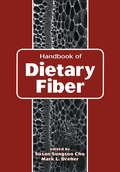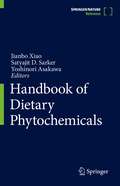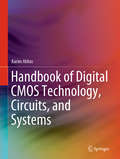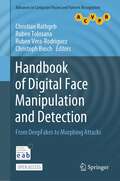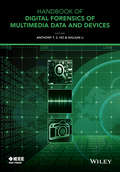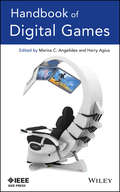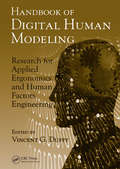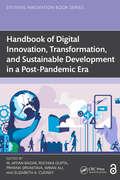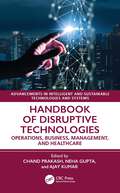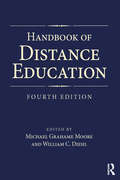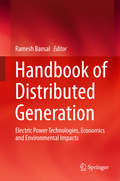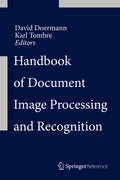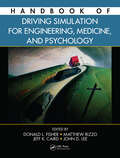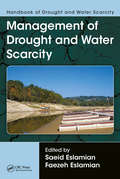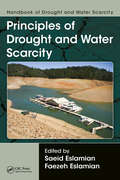- Table View
- List View
Handbook of Diesel Engines
by Krister G. Johnson Helmut Tschöke Klaus MollenhauerThe diesel engine continues to be the most cost-effective internal combustion engine for motor vehicles as well as road and nonroad engine applications. The diesel engine is superior to all other drive engines in terms of flexibility, performance, emissions and ruggedness, particularly in the context of the current CO2 discussions. The intensive search for alternative drive concepts, e. g. hybrid or purely electric drives, has demonstrated the indispensability of diesel engines for cost-effective long-distance operation and wherever energy carriers have high energy densities, i. e. fuel storage capacities are limited. This English edition of the Handbook of Diesel Engines provides a comprehensive overview of diesel engines of all sizes from small single cylinder engines up to large two-stroke marine engines. The handbook is geared toward experts working in research and development and industry as well as students studying engineering, mechatronics, electrical engineering or electronics.
Handbook of Dietary Fiber: An Applied Approach (Food Science And Technology Ser. #Vol. 25)
by Susan Sungsoo Cho; Mark L. DreherPresents the latest research on the analysis, metabolism, function, and physicochemical properties of fiber, fiber concentrates, and bioactive isolates--exploring the effect of fiber on chronic disease, cardiovascular health, cancer, and diabetes. Examines food applications and the efficacy and safety of psyllium, sugar beet fiber, pectin, alginate, gum arabic, and rice bran.
Handbook of Dietary Phytochemicals
by Satyajit D. Sarker Yoshinori Asakawa Jianbo XiaoThis book summarizes recent advances in the chemistry, bioactivity, nutrition, and functional aspects of dietary phytochemicals, as well as the health and functional aspects of foods rich in phytochemicals. Consisting of forty-four chapters, it discusses the different chemical types of phytochemicals in our diets and food and presents data collected from animal or human experiments that are directly related to human health. Each chapter covers the chemistry, epidemiological study, bioavailability, bioactivity (animal experiments) function in humans and safety, as well as products on the market. Moreover, the more than 200 figures make it easy to grasp the main findings in each area.
Handbook of Digital CMOS Technology, Circuits, and Systems
by Karim AbbasThis book provides a comprehensive reference for everything that has to do with digital circuits. The author focuses equally on all levels of abstraction. He tells a bottom-up story from the physics level to the finished product level. The aim is to provide a full account of the experience of designing, fabricating, understanding, and testing a microchip. The content is structured to be very accessible and self-contained, allowing readers with diverse backgrounds to read as much or as little of the book as needed. Beyond a basic foundation of mathematics and physics, the book makes no assumptions about prior knowledge. This allows someone new to the field to read the book from the beginning. It also means that someone using the book as a reference will be able to answer their questions without referring to any external sources.
Handbook of Digital Face Manipulation and Detection: From DeepFakes to Morphing Attacks (Advances in Computer Vision and Pattern Recognition)
by Ruben Vera-Rodriguez Christoph Busch Christian Rathgeb Ruben TolosanaThis open access book provides the first comprehensive collection of studies dealing with the hot topic of digital face manipulation such as DeepFakes, Face Morphing, or Reenactment. It combines the research fields of biometrics and media forensics including contributions from academia and industry. Appealing to a broad readership, introductory chapters provide a comprehensive overview of the topic, which address readers wishing to gain a brief overview of the state-of-the-art. Subsequent chapters, which delve deeper into various research challenges, are oriented towards advanced readers. Moreover, the book provides a good starting point for young researchers as well as a reference guide pointing at further literature. Hence, the primary readership is academic institutions and industry currently involved in digital face manipulation and detection. The book could easily be used as a recommended text for courses in image processing, machine learning, media forensics, biometrics, and the general security area.
Handbook of Digital Forensics of Multimedia Data and Devices (Wiley - IEEE)
by Shujun Li Anthony T.S. HoDigital forensics and multimedia forensics are rapidly growing disciplines whereby electronic information is extracted and interpreted for use in a court of law. These two fields are finding increasing importance in law enforcement and the investigation of cybercrime as the ubiquity of personal computing and the internet becomes ever-more apparent. Digital forensics involves investigating computer systems and digital artefacts in general, while multimedia forensics is a sub-topic of digital forensics focusing on evidence extracted from both normal computer systems and special multimedia devices, such as digital cameras. This book focuses on the interface between digital forensics and multimedia forensics, bringing two closely related fields of forensic expertise together to identify and understand the current state-of-the-art in digital forensic investigation. Both fields are expertly attended to by contributions from researchers and forensic practitioners specializing in diverse topics such as forensic authentication, forensic triage, forensic photogrammetry, biometric forensics, multimedia device identification, and image forgery detection among many others.Key features: Brings digital and multimedia forensics together with contributions from academia, law enforcement, and the digital forensics industry for extensive coverage of all the major aspects of digital forensics of multimedia data and devices Provides comprehensive and authoritative coverage of digital forensics of multimedia data and devices Offers not only explanations of techniques but also real-world and simulated case studies to illustrate how digital and multimedia forensics techniques work Includes a companion website hosting continually updated supplementary materials ranging from extended and updated coverage of standards to best practice guides, test datasets and more case studies
Handbook of Digital Games
by Marios C. Angelides Harry AgiusA thorough discussion of the present and future of digital gaming People play digital games for many reasons, from entertainment to professional training, but all games share the same basic characteristics. From those basic parameters, gaming professionals manage to create the enormous variety of games on the market today. The Handbook of Digital Games explores the many considerations and variables involved in game creation, including gaming techniques and tools, game play, and game design and development. A team of recognized gaming experts from around the world shares their thoughts on the different aspects of game creation, providing readers with a deep understanding and insider perspective on the cross-disciplinary aspects of the industry. The fundamentals are discussed, but the emphasis is on emerging theory and technology with topics including: Player experience and immersion, including emotion Automatic content generation and storytelling techniques Collaboration and social information exchange Game aesthetics Simulation of game play and crowds Collision detection Networking issues such as synchronization The book also includes retrospective and ontological examinations of gaming, as well as discussions about mobile game play, spatial game structures, and education-centric gaming. In-game advertising, gender stereotyping, and independent game production are also considered. The Handbook of Digital Games is a robust compilation of the latest information across the entire industry, and a major resource for any gaming professional.
Handbook of Digital Homecare
by Lodewijk Bos Adrie Dumay Kanagasingam Yogesan Leonard Goldschmidt Griet VerhennemanThis second volume of the "Handbook of Digital Homecare" reviews the attempts to develop new ICT services for digital homecare, i.e. services to deliver, maintain and improve care in the home environment using the latest ICT technology and devices. The book highlights the successful projects as well as failures of Digital homecare and provides several "lessons learned" to the wide audience of Health and ICT professionals.
Handbook of Digital Human Modeling: Research for Applied Ergonomics and Human Factors Engineering (Human Factors and Ergonomics)
by Vincent G. DuffyThe rapid introduction of sophisticated computers, services, telecommunications systems, and manufacturing systems has caused a major shift in the way people use and work with technology. It is not surprising that computer-aided modeling has emerged as a promising method for ensuring products meet the requirements of the consumer. The Handbook of D
Handbook of Digital Innovation, Transformation, and Sustainable Development in a Post-Pandemic Era (Systems Innovation Book Series)
by Imran Ali Elizabeth A. Cudney Ruchika Gupta Priyank Srivastava M. Affan BadarBusinesses have faced a variety of difficulties as a result of the global pandemic, and how they responded to this disruption has affected both their resilience and their ability to get through this crisis. Digital technologies have played a crucial role in addressing these issues and fostering resilience. It is, therefore, imperative to explore options for post-pandemic business transformation and rethinking sustainable development.Handbook of Digital Innovation, Transformation, and Sustainable Development in a Post-Pandemic Era, covers digital innovation and business transformation to build resilience for sustainable development and growth and highlights the impact of supply chain disruptions and solutions to sustain. The handbook stands out for its inclusion of industry cases from various regions across the globe. By presenting the use of big data, blockchain technology, and Industry 4.0, the handbook conveys how to work towards sustainable development and offers self-reliant and sustainable business models.Researchers and practitioners in industrial engineering, engineering management, business management, supply chain management, and digital technologies along with businesses can apply the research and practices covered in the handbook.Chapters 3 and 14 of this book is freely available as a downloadable Open Access PDF at http://www.taylorfrancis.com under a Creative Commons Attribution-Non Commercial-No Derivatives (CC-BY-NC-ND) 4.0 license.
Handbook of Digital Twins
by Zhihan LyuOver the last two decades, Digital Twins (DTs) have become the intelligent representation of future development in industrial production and daily life. Consisting of over 50 chapters by more than 100 contributors, this comprehensive handbook explains the concept, architecture, design specification and application scenarios of DTs.As a virtual model of a process, product or service to pair the virtual and physical worlds, DTs allow data analysis and system monitoring by using simulations. The fast-growing technology has been widely studied and developed in recent years. Featured with centralization, integrity and dynamics, it is cost-effective to drive innovation and performance. Many fields saw the adaptation and implementation across industrial production, healthcare, smart city, transportation and logistics. World-famous enterprises such as Siemens, Tesla, ANSYS and General Electric have built smart factories and pioneered digital production, heading towards Industry 4.0.This book aims to provide an in-depth understanding and reference of DTs to technical personnel in the field, students and scholars of related majors, and general readers interested in intelligent industrial manufacturing.
Handbook of Disaster Risk Reduction for Resilience: New Frameworks for Building Resilience to Disasters
by Saeid Eslamian Faezeh EslamianThis book is part of a six-volume series on Disaster Risk Reduction and Resilience. The series aims to fill in gaps in theory and practice in the Sendai Framework, and provides additional resources, methodologies and communication strategies to enhance the plan for action and targets proposed by the Sendai Framework. The series will appeal to a broad range of researchers, academics, students, policy makers and practitioners in engineering, environmental science and geography, geoscience, emergency management, finance, community adaptation, atmospheric science and information technology. This volume discusses how to measure and build disaster resilience at society’s capacity, drawing upon individual, institutional and collective resources to cope with and adapt to the demands and challenges of natural disaster occurrences. The book will serve as a guide, outlining the key indicators of disaster resilience in urban and rural settings, and the resources and strategies needed to build resilient communities in accordance with the targets of the Sendai Framework. Readers will learn about multi-risk reduction approaches using computational methods, data mining techniques, and System Thinking at various scales, as well as institutional and infrastructure resilience strategies based on several case studies.
Handbook of Diseases of Banana, Abacá and Enset
by David R. JonesThis book provides a comprehensive guide to the large number of diseases, disorders and injuries that can cause severe economic losses to banana, abacá and enset crops, and the fungi, bacteria, phytoplasmas, viruses, nematodes and abiotic factors involved. The monoculture of certain banana cultivars in large plantations make the crop particularly susceptible to catastrophic losses from disease and small holders can also experience major problems. New approaches to breeding, crop management and handling are being developed to meet challenges posed by emerging threats.
Handbook of Disruptive Technologies: Operations, Business, Management, and Healthcare (Advancements in Intelligent and Sustainable Technologies and Systems)
by Ajay Kumar Neha Gupta Chand PrakashThis handbook addresses how smart operations, management, and healthcare can be used to detect and analyze supply chain problems, business problems, and diseases. It also discusses the underlying methodologies and related security concerns.Handbook of Disruptive Technologies: Operations, Business, Management, and Healthcare provides updated and timely insights, unique approaches or frameworks, practical applications, and case studies. It provides in-depth knowledge of disruptive technologies and applies data analytics to different areas to solve complex situations. The handbook uses data analytics in decision-making and policy framing and identifies practices and applications of disruptive technologies that can assist organizations in gaining a competitive advantage. Valuable insights, innovative approaches, practical applications, and case studies can be found in this handbook as it effectively consolidates and synthesizes information to provide a comprehensive understanding of the subject matter.This book is tailored for researchers, academics, and professionals seeking to deepen their knowledge in the field.
Handbook of Distance Education
by Michael Grahame MooreThe third edition of this award-winning Handbook continues the mission of its predecessors: to provide a comprehensive compendium of research in all aspects of distance education, arguably the most significant development in education over the past three decades. While the book deals with education that uses technology, the focus is on teaching and learning and how its management can be facilitated through technology. Key features include: Comprehensive coverage that includes all aspects of distance education, including design, instruction, management, policy, and a section on different audiences. Chapter authors frame their topic in terms of empirical research (past and present) and discuss the nature of current practice in terms of that research. Future research needs are discussed in relation to both confirmed practice and recent changes in the field. Section one provides a unique review of the theories that support distance education pedagogy. Section six includes a unique review of distance education as a component of global culture. This book will be of interest to anyone engaged in distance education at any level. It is also appropriate for corporate and government trainers and for administrators and policy makers in all these environments. Recipient of the 2013 IAP Distance Education Book Award
Handbook of Distance Education: Second Edition
by Michael Grahame MooreThe Handbook of Distance Education, 4th Edition is a comprehensive compendium of research in the field of distance education. The volume is divided into four sections covering the historical and theoretical foundations of distance education, attributes of teaching and learning using technology, management and administration, and different audiences and providers. Throughout, leading scholars address future research needs and directions based on current research, established practices, and recent changes to implementation, pedagogy, and policy.
Handbook of Distributed Generation
by Ramesh BansalThis book features extensive coverage of all Distributed Energy Generation technologies, highlighting the technical, environmental and economic aspects of distributed resource integration, such as line loss reduction, protection, control, storage, power electronics, reliability improvement, and voltage profile optimization. It explains how electric power system planners, developers, operators, designers, regulators and policy makers can derive many benefits with increased penetration of distributed generation units into smart distribution networks. It further demonstrates how to best realize these benefits via skillful integration of distributed energy sources, based upon an understanding of the characteristics of loads and network configuration.
Handbook of Document Image Processing and Recognition
by David Doermann Karl TombreThe Handbook of Document Image Processing and Recognition is a comprehensive resource on the latest methods and techniques in document image processing and recognition. Each chapter provides a clear overview of the topic followed by the state of the art of techniques used - including elements of comparison between them - along with supporting references to archival publications, for those interested in delving deeper into topics addressed. Rather than favor a particular approach, the text enables the reader to make an informed decision for their specific problems.
Handbook of Domestic Ventilation
by Rodger EdwardsA series of studies of homes in England show that around 15% - or some 3 million homes - suffer problems with damp and mould, largely because of poor ventilation. The impact on public health and quality of life is substantial.The Handbook of Domestic Ventilation is a comprehensive study of the basic science, technology and practical application of effective and energy efficient ventilation strategies for dwellings. Unlike other books, the Handbook concentrates on a domestic context rather than looking solely at commercial applications, giving a much needed insight into the requirements of ventilation for the home. Basing his conclusions on both theoretical study and practical experience, Rodger Edwards demonstrates the clear link between poor ventilation and poor health, and tells the reader how to use good quality ventilation as a way of enhancing quality of life and as a health improvement tool.
Handbook of Dough Fermentations
by Klaus Lorenz Karel KulpHandbook of Dough Fermentations describes the preparation of ferments and utilization of starters in the commercial baking and food industries and offers in-depth discussion on the modification of sourdough processes in the production of common bakery products, as well as the microbiological principles, fermentation pathways, product formulations, and technological methodologies relating to these procedures. This unique reference examines statistical market trends for fermented cereal, yeast, and natural and sourdough products. It pinpoints areas of potential for products and foods using fermentation science and analyzes the application of starters in the production of specific products.
Handbook of Drivers of Continuous Improvement in Construction Health, Safety, and Wellbeing
by Riza Yosia Sunindijo Fidelis Emuze Che Khairil Izam Che Ibrahim Abimbola Windapo Nnedinma Umeokafor Tariq Umar Jochen TeizerThis Handbook presents opportunities, best practices, and case studies backed by cutting edge research on the drivers of continuous improvement of health, safety, and wellbeing in the architecture, engineering, construction, and facility management sector. The book consists of 23 chapters with six themes covering:● Drivers of the business case for healthier and safer construction● Opportunities and drivers of digital technologies for improving health and safety ● Drivers of human factors for improving health and safety● Drivers of safer design and procurement ● Drivers of better health and wellbeing for construction.● Opportunities for driving equality and inclusivity for safer construction.The book will be beneficial to academics, undergraduate and postgraduate (research and taught) students, professional institutions (such as the Institution of Occupational Safety and Health), health and safety professionals (health and safety officers, consultants and managers), occupational health professionals, mental health and wellbeing professionals, construction managers, architects, project professionals, engineers (design, construction, project, site, electrical, mechanical, civil, building services, and structural), facilities managers, quantity surveyors, and site managers. The aim of the book is to provide critical perspectives alongside evidence based practical examples of success stories, that should inspire readers and engender continuous improvement in health, safety, and wellbeing in the construction industry.
Handbook of Driving Simulation for Engineering, Medicine, and Psychology
by John D. Lee Matthew Rizzo Donald L. Fisher Jeff K. CairdEffective use of driving simulators requires considerable technical and methodological skill along with considerable background knowledge. Acquiring the requisite knowledge and skills can be extraordinarily time consuming, yet there has been no single convenient and comprehensive source of information on the driving simulation research being conduc
Handbook of Drought and Water Scarcity: Environmental Impacts and Analysis of Drought and Water Scarcity
by Saeid Eslamian Faezeh A. EslamianThis volume includes over 30 chapters, written by experts from around the world. It examines the environmental aspects of drought such as groundwater and soil contamination, river low-flow, urban water quality, and desertification. It also examines the effects of climate change and variability on drought, and discusses the differences in groundwater, rainfall, and temperatures and their related effects. It presents analytical modeling for better understanding drought in uncertain and changing climates.
Handbook of Drought and Water Scarcity: Management of Drought and Water Scarcity
by Saeid Eslamian Faezeh A. EslamianThis volume includes over 30 chapters, written by experts from around the world. It examines numerous management strategies for dealing with drought and scarcity. These strategies include management approaches for different regions, such as coastal, urban, rural, and agricultural areas. It offers multiple strategies for monitoring, assessing, and forcasting drought through the use of remote sensing and GIS tools. It also presents drought mitigation management strategies, such as groundwater management, rainwater harvesting, conservations practices, and more.
Handbook of Drought and Water Scarcity: Principles of Drought and Water Scarcity
by Saeid Eslamian Faezeh A. EslamianThis volume include over 30 chapters, written by experts from around the world. It examines drought and all of the fundamental principles relating to drought and water scarcity. It includes coverage of the causes of drought, occurences, preparations, drought vulnerability assessments, societal implications, and more.

